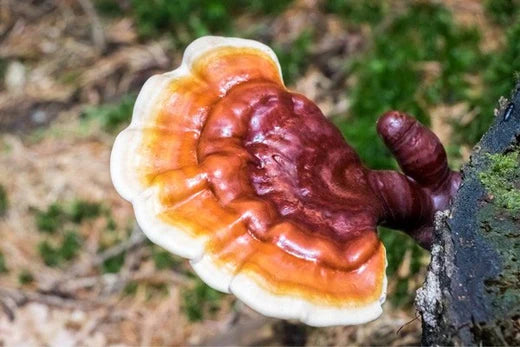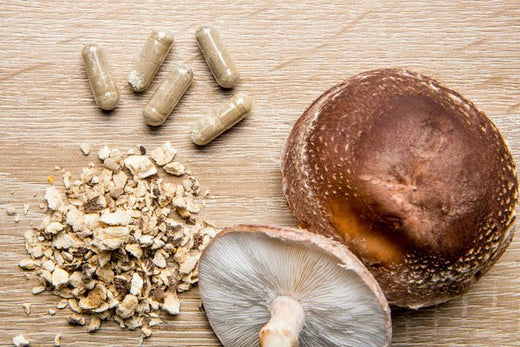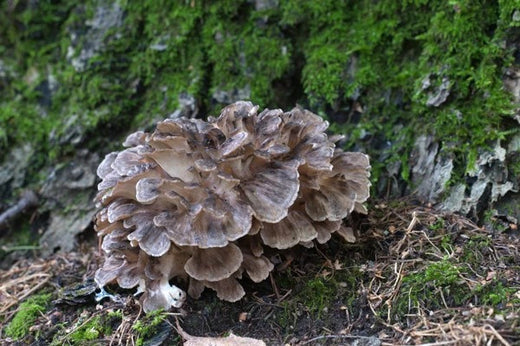Mushroom Anatomy | A Segmented Explanation

Mushrooms are a truly distinctive life form, setting themselves apart from both the animal and plant kingdoms.
Belonging to their own kingdom of fungi, they play a vital role in forming a complex mycorrhizal network that weaves through the earth's crust. This network transports essential bacteria and nutrients to plants, trees, and animals, facilitating connection, communication, and thriving ecosystems.
As fungi are neither animals nor plants, they possess a unique structure that seamlessly integrates with our DNA and cell biology. Our immune cells even have specific fungal receptors, underscoring the importance of mushrooms in immune health and longevity.
One of the most remarkable aspects of mushrooms is the evidence suggesting that human biology has evolved to have specific receptors activated or "switched on" solely by consuming mushrooms.
The anatomy of a mushroom offers a wealth of knowledge and insight. Each part – the stem or stalk, cap, fruiting body, ring, mycelial network, and spores – has unique benefits that support both human health and the planet.
Join us as we explore the fascinating world of mushrooms and learn how each component contributes to our well-being and the health of our environment.

Mushrooms Anatomy
Since ancient times, mushrooms have been valued for their medicinal properties and their ability to promote longevity.
Renowned Greek physician Hippocrates, often referred to as the Father of Modern Medicine, documented the anti-inflammatory benefits of mushrooms, while ancient Chinese texts from 5,000 years ago highlighted their role in promoting well-being and spiritual growth. In Europe, mushrooms have long been used for both nutrition and medicine in traditional folk practices.
Mushrooms have captivated humans with their unique shapes, diverse varieties, intricate structures, and powerful health effects on our bodies. By incorporating culinary mushrooms into our regular diets or consuming medicinal mushrooms daily, we can unlock their numerous health benefits and embrace their status as a true superfood.
Nutritionally, mushrooms are packed with amino acids – the essential building blocks of protein that contribute to a healthy mood, muscle growth, immune health, and DNA replication. They are also rich in chitin and distinctive polysaccharides called beta-glucans, which support gut health and immune system regulation. Furthermore, mushrooms contain an abundance of vitamins and minerals that promote healthy cell function and overall well-being.
Delving into the fascinating world of mushroom anatomy allows us to better understand the unique properties and types of mushrooms, and appreciate their importance in maintaining a healthy diet, enhancing our well-being, and connecting with the natural world.
Understanding Mushroom Spores
Just as seeds are essential for the growth of plants and trees, spores are the key to the life cycle of fungi. In fact, mushroom spores are like the tiny, pre-baby versions of mushrooms waiting to sprout into existence.
Interestingly, all spores are created equal as they are asexual, meaning they don't have a male or female designation like some plant seeds do. But despite their small size, these spores are powerful reproductive units that play a vital role in the growth and spread of mushrooms.
Every day, trillions of spores are released from the gills and pores of mushrooms, drifting in the air in search of the perfect environment and ideal conditions to germinate. And once they find the right spot, these amazing spores contain everything needed to form an entirely new type of fungus. It's truly a fascinating process!
Steams and Caps
As mushroom spores start to germinate, they give rise to a nascent mushroom in which the stem and cap begin taking shape. This stage is commonly referred to as the button stage. As the mushrooms continue to develop, they eventually "sprout" above ground. In the final phase of maturation, the fungus forms its fruiting body.
The fruiting body of a mushroom, consisting of the stem and cap, is the part we typically recognize and consume. When purchasing button mushrooms from your local grocery store or farmers market, you're buying the fruiting body of the Agaricus Bisporus species.
Mushrooms typically have a semi-spherical cap with gills underneath and a straight stalk. However, some fungi species exhibit unique stem and cap formations. For example, the Lion's Mane mushroom (Hericium Erinaceus) features a "bearded tooth" cap with a white, icicle-like appearance, resembling a lion's mane.
Another distinct example is the Turkey Tail mushroom, whose cap resembles layers of coral or petals, making it easily identifiable and visually striking.

Gills., Pores and More
- Scales
Did you know that mushrooms have fascinating features that make them unique and easy to identify in the wild? Mushroom scales, for instance, are pigmented plates that act as a protective layer covering the mushroom. These scales are responsible for the spots you see on mushrooms and can be used to identify different species.

Lion's Mane Mushroom (Hericium erinaceus)
- Gills and Pores
Another exciting part of the mushroom is the gills or lamellae, which are responsible for producing spores - the mushroom's reproductive part. These gills can appear as teeth or tubes on the underside of the cap, and they vary from one species to another. The Lion's Mane mushroom, for instance, has unique gills that resemble a lion's mane, giving it a distinctive appearance. This mushroom is also known as the "pom pom" mushroom.
While some mushroom species have elongated gills, others have small holes underneath the cap, resembling a sponge. Reishi mushroom and Turkey Tail are two examples of mushrooms with pores instead of gills.

- Rings
Lastly, the ring anatomy of a mushroom is a membrane that encases part of the stem underneath the fruiting body. These features make mushrooms unique and exciting to learn about, and you never know what fascinating feature you may discover in the wild!
FAQs
What is the pinnacle of a mushroom?
The mushroom's crown, known as the fruiting body, consists of the cap and stem we often see above ground.
What is a stalk in the mushroom kingdom?
The mushroom stalk, a crucial element in mushroom anatomy, provides the main support for the regal fruiting body and cap.

What's the secret world of mycelium?
Mycelium, the hidden underground network of mushroom colonies, comes to life when two spores unite and form a complex web of branching tubular structures called hyphae. When compatible hyphae intertwine, they create an intricate mycelial web.
Hyphae act as nature's transport system, absorbing nutrients from the soil and carrying them to different parts of the mushroom. These connections also allow fungi and plants to exchange nutrients, creating a mutually beneficial partnership for a higher chance of thriving in their environment.
What role does the mushroom cap play in fungal anatomy?
The mushroom cap, the uppermost part of the fruiting body, is a treasure trove of medicinal properties. It's the key ingredient in many high-quality mushroom extracts, making the fruiting body and cap essential elements of the mushroom's healing powers.
Concluding
In a nutshell, the wondrous world of mushroom anatomy is truly captivating and offers numerous benefits for both human health and the environment. Each component of the mushroom plays a significant role in its functionality.
We often recognize the fruiting body as the typical mushroom we see above ground, and this is the part we mainly consume due to its rich concentration of nutrients and health advantages. However, it's worth mentioning that any toxins in mushrooms are also concentrated in the fruiting body.
Mushrooms possess a sponge-like quality in the wild, making them incredibly effective in cleaning up and recycling their surroundings. To ensure you're reaping the benefits of these fantastic fungi, opt for certified organic mushrooms sourced from pristine environments.
Delving deeper into mushroom anatomy, the mycelium is a vital underground fungal network that plays a crucial role in Earth's ecosystem and survival. Additionally, mushrooms are equipped with gills, scales, and spores, which facilitate the continuation of the mushroom life cycle.
References
Medicinal Mushrooms: Ancient Remedies Meet Modern Science - https://www.ncbi.nlm.nih.gov/pmc/articles/PMC4684114/
Isokauppila, Tero. Healing Mushrooms. Prentice Hall Press
Powell, Martin. Medicinal Mushrooms - A Clinical Guide
Adaptogens: Herbs for Strength, Stamina, and Stress Relief. Book by David Winston and Steven Maimes
Written by Eliza Hedley
Eliza Hedley is a health, mindset and abundance enthusiast obsessed with helping millennial's experience living at a higher level.
Eliza's relaxed new age approach and understanding of nutrition and wellness sees her empowering and coaching individuals to understand that their health is the ultimate asset. Upon experiencing first hand the power and place of tonic herbalism and medicinal mushrooms in everyday life, Eliza’s become an adaptogen fangirl and feels their utilisation in today’s world is essential for abundance and wellbeing.






